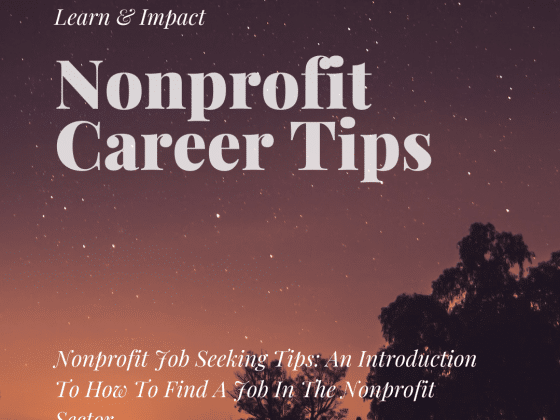In this article, we will explore the benefits and challenges of working in nonprofit jobs. We’ll also discuss the realities of working in the sector—insights that are crucial for both newcomers and experienced professionals. These topics apply to all core nonprofit roles across nonprofit organizations, foundations, associations, unions, schools, and other mission-driven entities.
Nonprofit Job Seeking 101
Before pursuing a nonprofit job, it’s important to understand both the rewards and the challenges of working in the sector. Nonprofits and foundations operate with different motivations, structures, and expectations than for-profit companies. Let’s start with the benefits and what makes nonprofit jobs appealing.
1. The Mission-Driven Work Environment
Nonprofits, foundations, and educational institutions are attractive workplaces because they offer a strong sense of purpose and impact. Unlike the for-profit sector, where success is typically measured in revenue and profit, nonprofits prioritize social good, community impact, and systemic change. This leads to a unique work culture where employees feel deeply connected to their organization’s mission.
Why this matters in your job search:
- Passion and alignment with the mission are essential. Nonprofit employers expect candidates to bring more than just a strong resume—they look for individuals who are truly invested in their cause.
- The ability to showcase relevant experiences, volunteer work, or personal connections to the mission can set you apart from other candidates.
- More than ever, job seekers are looking for meaningful work, and nonprofit employers are balancing that desire with the realities of staffing needs.
With the increasing demand for remote and hybrid work, many nonprofits are still finding the right balance. Some roles offer flexible arrangements, while others require in-person collaboration due to the hands-on nature of nonprofit work. Staying adaptable and open to the organization’s operational needs can improve your chances of securing a role.
How to stand out:
- Demonstrate your experience and skills that align with the responsibilities of the role.
- Showcase a positive, proactive approach to nonprofit work.
- Express long-term interest in the role and the organization’s mission.
- Highlight how your outside activities—such as volunteering, community involvement, or philanthropy—connect to the organization’s goals.
2. The People You Work With
One of the biggest benefits of nonprofit jobs is the people. Nonprofit professionals are often passionate, open to change, and deeply invested in their communities. This leads to a workplace culture that is collaborative, mission-focused, and values-driven.
Key Differences from the For-Profit Sector:
- Nonprofit workplaces often encourage participatory decision-making, which fosters inclusivity but can also slow down hiring and operational decisions.
- Unlike for-profit organizations, where leadership decisions are typically top-down, nonprofit leaders must often seek input from boards, committees, and stakeholders before making key decisions.
Although nonprofit hiring processes can take longer than in the corporate world, they emphasize stability, reliability, and shared commitment to the mission. This is especially important in leadership roles, where executives must justify decisions to a board of directors and align them with long-term strategic goals.
How Networking Helps in Nonprofit Careers:
- Nonprofit hiring heavily relies on networking. Building relationships within the sector is one of the best ways to secure a job.
- Unlike in for-profit settings, where excessive networking can sometimes be seen as intrusive, nonprofit employers expect candidates to engage with their work, read their publications, attend their events, and connect with their staff.
- Volunteering and direct involvement in an organization’s programs can provide a strong advantage in the hiring process.
If you are genuinely interested in working for a nonprofit, take the time to understand its mission, attend its events, and build relationships with current employees. The information needed to secure a job lead is often openly available on the organization’s website, including volunteer opportunities and contact information for key decision-makers.
The Challenges of Seeking Nonprofit Jobs
While nonprofit work offers meaningful opportunities, there are challenges to consider when seeking and maintaining a career in the sector.
1. Finding the Right Position and Sticking With It
One of the biggest challenges in nonprofit careers is selecting a role that aligns with both your skills and long-term career goals.
Many job seekers initially believe they would be a great fit for nonprofit roles such as event fundraising or grant writing, but they often leave these roles within a few years. This high turnover is particularly common in specialized areas like development and grant writing, where professionals either transition into higher leadership positions or become consultants.
How to build a sustainable nonprofit career:
- Choose a role that genuinely interests you and aligns with your skills.
- Gain experience through volunteering or board service to strengthen your qualifications.
- Understand that switching functional areas (e.g., from finance to programs or operations to marketing) can be challenging without direct experience.
For senior professionals looking to transition into the nonprofit sector, joining a board or nonprofit committee can provide the relevant experience needed to make the shift.
2. Choosing and Sticking to a General Area of Interest
Many nonprofit job seekers are surprised when they don’t get selected for a position, even if they made it to the final interview rounds. The main reason? Another candidate had direct experience in both the nonprofit’s industry and functional area.
For example, an education nonprofit will often prefer candidates with experience in education, and an arts organization will seek candidates who have previously worked in the arts sector. While transitions are possible, they require careful planning and strategic career moves.
How to increase your chances of success:
- Stay within your sector whenever possible to build expertise.
- Be intentional about where you gain experience and how it aligns with your career goals.
- If transitioning to a new field, gain hands-on experience through volunteering or nonprofit board service.
3. Organizational Structures and Leadership Dynamics
The nonprofit sector is diverse in staffing but can sometimes be rigid in governance and decision-making.
Many nonprofits operate with a hierarchical structure where the Executive Director or CEO reports to a board of directors. While this model provides oversight, it can also create challenges:
- Board members, who serve as unpaid volunteers, often take a conservative approach to decision-making, prioritizing stability over risk-taking.
- Some nonprofits limit their own growth by focusing on budget constraints rather than exploring new revenue-generating opportunities.
- Unlike for-profit organizations, where shareholders drive innovation and competition, nonprofit boards may be more hesitant to push for change due to fear of failure.
Overcoming these challenges:
- Strong executive leadership is key. Nonprofit CEOs and Executive Directors must advocate for strategic growth and educate their boards on the importance of investment in innovation.
- Boards should serve as policy-making bodies rather than getting too involved in day-to-day operations.
- Organizations should ask big-picture questions: How can we make the most impact? What resources do we need to achieve this? Are we thinking boldly enough?
While nonprofit governance structures create stability, they can also lead to stagnation if organizations don’t embrace strategic change. Successful nonprofits balance financial responsibility with a willingness to evolve, ensuring they remain competitive and impactful in their mission.
Things to keep in mind
Working in the nonprofit sector can be incredibly rewarding, but it requires dedication, adaptability, and a strong alignment with an organization’s mission. To build a successful nonprofit career, job seekers should focus on:
- Finding a role that matches their passion and skills.
- Building relationships and networking within the sector.
- Gaining relevant experience through volunteering and professional involvement.
- Understanding the nuances of nonprofit structures and decision-making.
By staying strategic and committed, professionals can thrive in nonprofit careers while making a meaningful impact on the causes you care about.





